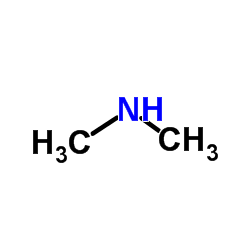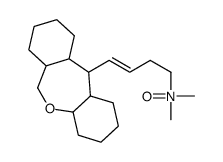Doxepin

Doxepin structure
|
Common Name | Doxepin | ||
|---|---|---|---|---|
| CAS Number | 1668-19-5 | Molecular Weight | 279.37600 | |
| Density | 1.122 g/cm3 | Boiling Point | 413.3ºC at 760 mmHg | |
| Molecular Formula | C19H21NO | Melting Point | 187-189ºC | |
| MSDS | N/A | Flash Point | 121.3ºC | |
Use of DoxepinDoxepin inhibits reuptake of serotonin and norepinephrine as a tricyclic antidepressant. Doxepin has therapeutic effects in atopic dermatitis,chronic urticarial,can improve cognitive processes, protect central nervous system. Doxepin has also been proposed as a protective factor against oxidative stress[1][2][3]. |
| Name | doxepin |
|---|---|
| Synonym | More Synonyms |
| Description | Doxepin inhibits reuptake of serotonin and norepinephrine as a tricyclic antidepressant. Doxepin has therapeutic effects in atopic dermatitis,chronic urticarial,can improve cognitive processes, protect central nervous system. Doxepin has also been proposed as a protective factor against oxidative stress[1][2][3]. |
|---|---|
| Related Catalog | |
| In Vitro | The protective effect of doxepin is associated with the enhancement of PSD-95 and synapsin 1 expression via PI3K/AKT/mTOR signaling pathway[4]. Western Blot Analysis[4] Cell Line: SH-SY5Y human neuroblastoma cell line Concentration: 10 ng/mL Incubation Time: 2 h Result: Improved the protein expre-ssion levels of PSD-95, synapsin 1 and p-AKT in SH-SY5Y cells, and decreased the protein expression level of p-mTOR in SH-SY5Y cells. |
| In Vivo | Doxepin (intraperitoneal injection of 1 mg/kg and 5 mg/kg doxepin once a day for 21 days) can protect against the Aβ1-42-induced memory impairment in rats[4]. Animal Model: SD male rats[4] Dosage: 1, 5mg/kg Administration: Doxepin (intraperitoneal injection of 1 mg/kg and 5 mg/kg doxepin once a day for 21 days) Result: Improved the protein expression levels of PSD-95 and synapsin 1 in hippocampus and tem-poral lobe, and decreased the protein expression level of p-AKT in hippocampus and temporal lobe after treatment of 1 mg/kg of doxepin. |
| References |
| Density | 1.122 g/cm3 |
|---|---|
| Boiling Point | 413.3ºC at 760 mmHg |
| Melting Point | 187-189ºC |
| Molecular Formula | C19H21NO |
| Molecular Weight | 279.37600 |
| Flash Point | 121.3ºC |
| Exact Mass | 279.16200 |
| PSA | 12.47000 |
| LogP | 3.96240 |
| Vapour Pressure | 4.87E-07mmHg at 25°C |
| Index of Refraction | 1.5000 (estimate) |
| Storage condition | Store at RT |
CHEMICAL IDENTIFICATION
HEALTH HAZARD DATAACUTE TOXICITY DATA
|
| Hazard Codes | T |
|---|---|
| Risk Phrases | 25 |
| Safety Phrases | 36/37/39-45 |
| HS Code | 2932999099 |
|
~71% 
Doxepin CAS#:1668-19-5 |
| Literature: SOMAXON PHARMACEUTICALS, INC. Patent: WO2008/85567 A1, 2008 ; Location in patent: Page/Page column 23; 24 ; |
|
~93% 
Doxepin CAS#:1668-19-5 |
| Literature: Gowda, Narendra B.; Rao, Gopal Krishna; Ramakrishna, Ramesha A. Tetrahedron Letters, 2010 , vol. 51, # 43 p. 5690 - 5693 |
|
~% 
Doxepin CAS#:1668-19-5 |
| Literature: US2007/281990 A1, ; Page/Page column 10 ; |
| HS Code | 2932999099 |
|---|---|
| Summary | 2932999099. other heterocyclic compounds with oxygen hetero-atom(s) only. VAT:17.0%. Tax rebate rate:13.0%. . MFN tariff:6.5%. General tariff:20.0% |
| Quitaxon |
| Aponal |
| P-3693A |
| Doxepine |
| Curatin |
| Docepin |
| Doxepin hydrochloride,11-(3-dimethylaminopropylidene)-6,11-dihydrodibenz[b,e]oxepinhydrochloride |
![11-(3-chloropropylidene)-6,11-dihydrodibenzo-[b,e]-oxepine structure](https://image.chemsrc.com/caspic/005/1221-23-4.png)


